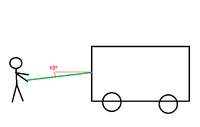I need to try to understand this kind of math more before my biometric paper is due in a few months. These practice questions represent the math I will need to be familiar with to construct my final paper, which is based on reconstructing accident scenes. Any help would be greatly appreciated, especially if you can share step by step processes and formula's so that I can eventually solve similar questions with set formula's. Thank you.
A) A cup that has a mass of 0.50 kg sits on a desk. Draw a free body diagram to determine the upward force exerted by the desk.
B.) Your mother borrows your truck and subsequently gets it stuck in some mud. She calls you & your brother to come rescue her. But when you arrive you decide to secure a steel cable in your tool box to a nearby tree. You & your brother then pull sideways on the cable at its midpoint & succeed in pulling the truck out of the mud. If you and your brother applied 400 N of force (F) on the cable, then what was the resulting force applied to the truck? θ = 10 ∘ Draw afree body diagram.
C.) You need to install of a new cyclotron at your local hospital. The cyclotron needs to be lifted with a engine hoist like device. So you install a chain at the center of the top of a crate containing the cyclotron. Then, you pull sideways with a direct horizontal force F. The cyclotron & crate have a combined mass of 1800kg. So what will the tension in the chain be when it makes an angle of
 with vertical? Also, what would be the force F? Draw the free body diagram.
with vertical? Also, what would be the force F? Draw the free body diagram.
A) A cup that has a mass of 0.50 kg sits on a desk. Draw a free body diagram to determine the upward force exerted by the desk.
B.) Your mother borrows your truck and subsequently gets it stuck in some mud. She calls you & your brother to come rescue her. But when you arrive you decide to secure a steel cable in your tool box to a nearby tree. You & your brother then pull sideways on the cable at its midpoint & succeed in pulling the truck out of the mud. If you and your brother applied 400 N of force (F) on the cable, then what was the resulting force applied to the truck? θ = 10 ∘ Draw afree body diagram.
C.) You need to install of a new cyclotron at your local hospital. The cyclotron needs to be lifted with a engine hoist like device. So you install a chain at the center of the top of a crate containing the cyclotron. Then, you pull sideways with a direct horizontal force F. The cyclotron & crate have a combined mass of 1800kg. So what will the tension in the chain be when it makes an angle of

